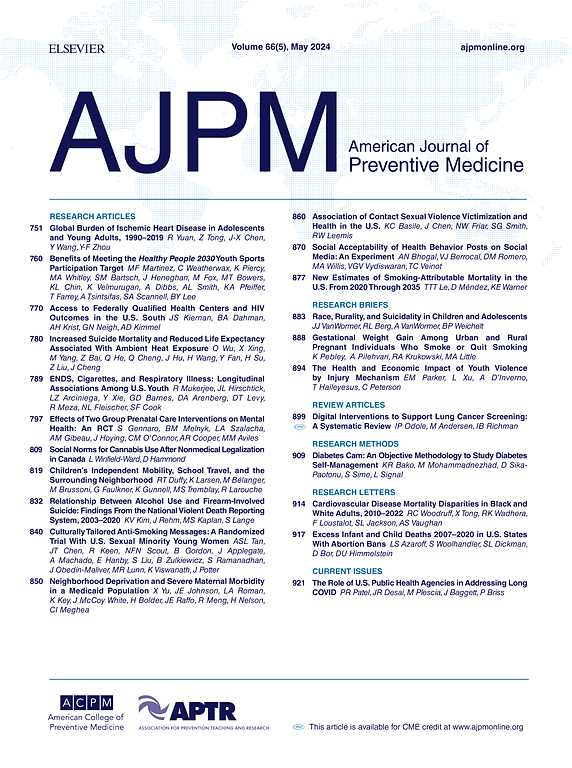Heterogeneity in Nicotine, Tobacco, and Cannabis Use Among U.S. Adolescents and Adults Aged 12–34 Years
IF 4.5
2区 医学
Q1 MEDICINE, GENERAL & INTERNAL
引用次数: 0
Abstract
Introduction
Nicotine, tobacco, and cannabis use continues to evolve in the U.S., with new forms of use (e.g., oral nicotine, cannabis edibles) emerging and increasing. It is critical to understand how these substances are being used and co-used. This study identified subgroups of adolescents and younger adults aged 12–34 years on the basis of nicotine, tobacco, and cannabis use using recent nationally representative data.
Methods
Cross-sectional data from the Population Assessment of Tobacco and Health Wave 7 (2022–2023) were used. Analyses focused on those aged 12–34 years who reported any past 30-day nicotine, tobacco, or cannabis use (n=8,722). Latent class analysis was conducted using 8 indicators: combustible tobacco use, nicotine vaping, oral nicotine product use, other noncombustible tobacco use (e.g., snus/chew), blunt use, cannabis smoking, cannabis vaping, and cannabis edibles. Differences were examined by sex, age, race, ethnicity, and region.
Results
On average, individuals reported use of approximately 2 products in the past 30 days (mean=2.08). Six subgroups of nicotine, tobacco, and cannabis use were identified: combustible tobacco (30.77%), multimodal cannabis (26.72%), vaping nicotine (18.37%), multimodal co-use (13.87%), cannabis edibles (5.31%), and multimodal nicotine/tobacco (4.95%). Sociodemographic characteristics were associated with class membership.
Conclusions
There is substantial heterogeneity in nicotine, tobacco, and cannabis use among U.S. adolescents and younger adults. Of particular concern is that most of the sample reported combustible use, including 3 subgroups that reported multiple modes of use. Continued surveillance of nicotine, tobacco, and cannabis use is needed, particularly as the products and their regulation continue to evolve.
在美国12-34岁的青少年和成年人中尼古丁、烟草和大麻使用的异质性。
在美国,尼古丁、烟草和大麻的使用继续发展,新的使用形式(如口服尼古丁、大麻食品)不断出现和增加。了解如何使用和共同使用这些物质是至关重要的。本研究利用最近的全国代表性数据,根据尼古丁、烟草和大麻的使用情况,确定了12至34岁的青少年和年轻人的亚组。方法:采用烟草与健康人口评估第7波(2022/23)的横断面数据。分析集中在过去30天内报告有尼古丁、烟草或大麻使用的12-34岁人群(n= 8722)。使用8个指标进行潜在分类分析:可燃烟草使用、尼古丁雾化、口服尼古丁产品使用、其他不可燃烟草使用(如鼻烟/咀嚼)、钝性使用、大麻吸烟、大麻雾化和大麻食品。研究人员根据性别、年龄、种族、民族和地区来考察差异。结果:平均而言,个人报告在过去30天内使用大约两种产品(M=2.08)。确定了尼古丁、烟草和大麻使用的六个亚组:可燃烟草(30.77%)、多模式大麻(26.72%)、电子烟尼古丁(18.37%)、多模式共同使用(13.87%)、大麻食用(5.31%)和多模式尼古丁/烟草(4.95%)。社会人口学特征与阶级成员有关。结论:在美国青少年和年轻人中,尼古丁、烟草和大麻的使用存在实质性的异质性。特别值得关注的是,大多数样本报告了可燃使用,包括三个报告多种使用方式的小组。需要继续监测尼古丁、烟草和大麻的使用情况,特别是在这些产品及其监管不断发展的情况下。
本文章由计算机程序翻译,如有差异,请以英文原文为准。
求助全文
约1分钟内获得全文
求助全文
来源期刊

American Journal of Preventive Medicine
医学-公共卫生、环境卫生与职业卫生
CiteScore
8.60
自引率
1.80%
发文量
395
审稿时长
32 days
期刊介绍:
The American Journal of Preventive Medicine is the official journal of the American College of Preventive Medicine and the Association for Prevention Teaching and Research. It publishes articles in the areas of prevention research, teaching, practice and policy. Original research is published on interventions aimed at the prevention of chronic and acute disease and the promotion of individual and community health.
Of particular emphasis are papers that address the primary and secondary prevention of important clinical, behavioral and public health issues such as injury and violence, infectious disease, women''s health, smoking, sedentary behaviors and physical activity, nutrition, diabetes, obesity, and substance use disorders. Papers also address educational initiatives aimed at improving the ability of health professionals to provide effective clinical prevention and public health services. Papers on health services research pertinent to prevention and public health are also published. The journal also publishes official policy statements from the two co-sponsoring organizations, review articles, media reviews, and editorials. Finally, the journal periodically publishes supplements and special theme issues devoted to areas of current interest to the prevention community.
 求助内容:
求助内容: 应助结果提醒方式:
应助结果提醒方式:


